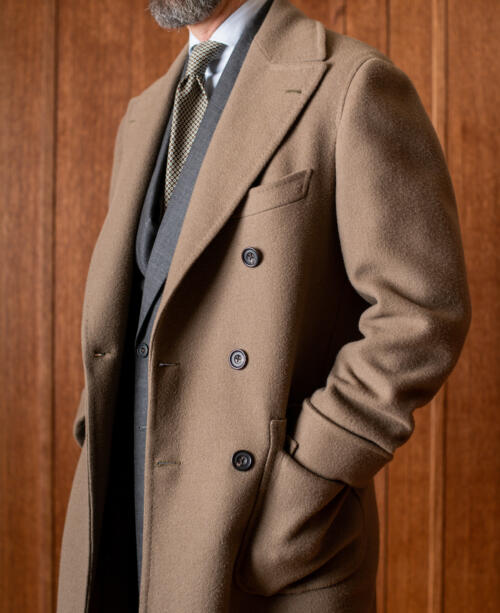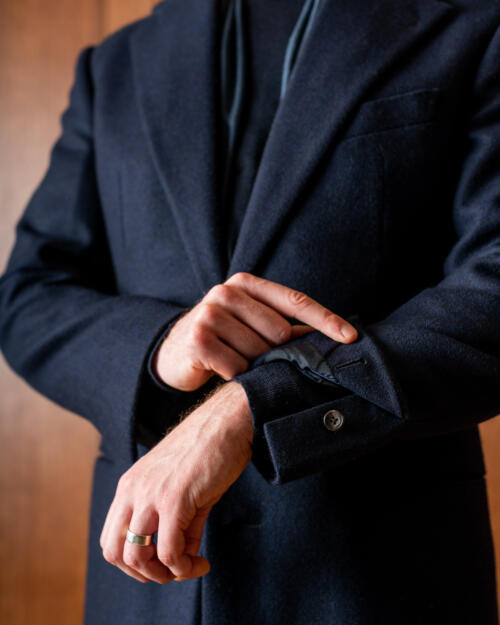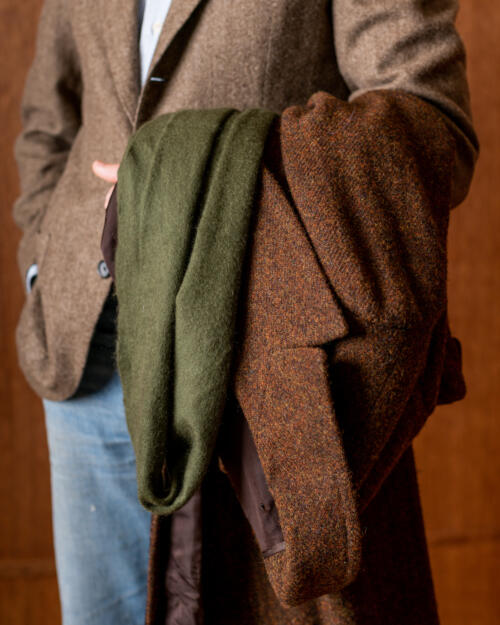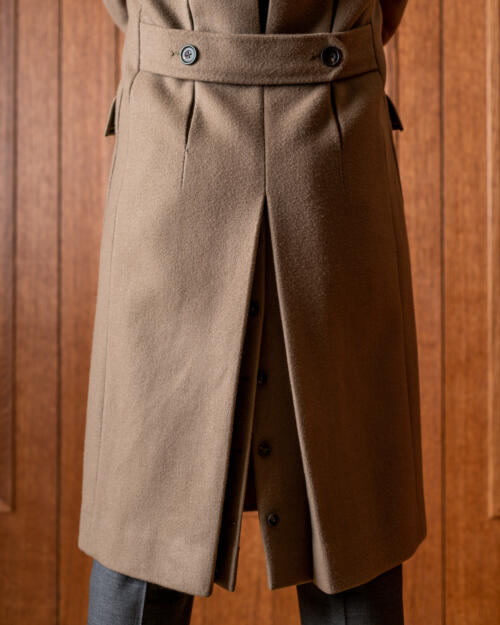Next week we’ll begin a series of articles that breaks down the style of my bespoke coats, building on the popular 2018 series that looked at suits and jackets.
That turned into a book, Bespoke Style, which was a great illustration of the rich variety in bespoke, from draped English to precise French to relaxed Neapolitan.
But with fewer people wearing suits, overcoats feel more relevant than ever, and that seems like the natural next step. I also think a bespoke overcoat is a truly beautiful thing, more versatile often than other tailoring, and probably more likely to be handed down the generations. My coats are my most commonly worn bespoke commissions, and some of my favourites.
The interesting thing about bespoke overcoats is that there are fewer obvious differences between tailors, but perhaps more in the details.
The way the back is constructed, for example, varies hugely. Some like the Florentines use one big pleat all the way down, simply tacking in the middle underneath the belt. Neapolitans are cleaner, perhaps surprisingly, while the French usually try to control everything, with the fullness stitched down in darts.
There is also a good amount of variation between tailors, and a lot between styles of coat. All Neapolitans don’t make an ulster the same, and a peak-lapelled guard’s coat is very different to either.
The aim of the series, therefore is not to be as comprehensive as the jackets/suits series, as that would essentially be impossible. Instead, it is to provide readers with the kind of tools that allow them to look at a bespoke coat and work out how and why they like it or they don’t.
This level of understanding, I find, releases a lot of enjoyment in bespoke. It’s less about arguing over how clean the back of a jacket should be, and other nitpicking forensics; it’s more about appreciating how something is made, what gives it style, and loving it more as a result.
That’s certainly been my experience with looking at my coats for this series, and I hope it’s yours too.
This introductory article is one I’ll refer people back to with any questions about the methodology, so I’ve included a few things below that will apply across the entries. If you have any questions let me know, and I can add them here as well.
How measurements are taken:
- Shoulder width: Length of the shoulder seam, from where it meets the collar (the neck point) to where it ends in the sleeve head
- Gorge height: Distance from the point of the lapel to the shoulder seam, vertically (this is probably misnamed, but it’s what we used in the last series so I’m sticking with it for consistency)
- Lapel width: From that point of the lapel to the inside edge of the coat, horizontally
- Buttoning point: From the waist button to the neck point in a straight line; on a DB, from halfway between the two waist buttons, to the neck point.
- Wrap: On a double breasted, the distance between the middle of the two waist buttons
- Back length: Length of the central back seam/line, from the bottom of the collar to the hem
My measurements (for context on the above)
- Height: Six foot / 183cm
- Chest: 39 inches / 99cm
- Waist: 33 inches / 84cm
- Inside leg: 31.5 inches usually (80cm)
Do note that throughout the series, as with the first set, we will be shooting the coats as they are, after years of wear. They have been well cared for, but have not been pressed specifically for the shoots. We feel this is more realistic and natural. The focus is also the style rather than the fit, which will usually have been covered in original reviews of the pieces.
We’ll start with the first coat, my ulster from Sartoria Ciardi in Naples, next week. Any questions on the clothes pictured, please hold off until then
































Looking forward to this .
I was going to commission a coat of some sorts but one question that put me off doing it was why have a coat made bespoke when it’s the most forgiving garment in terms of fit ?
i.e.. it didn’t need to be as well fitted as a suit or jacket .
I think the key takes I’ll be looking at , and if you’ll forgive my generalisations , is how to wear a coat that doesn’t make one look like an ‘Ulster Man’ on parade or a funeral director !
One of the most stylish coat looks I’ve seen is Michael Fassbender in the film ‘Shame’.
I certainly know what you mean about the value of bespoke there, and we’ve talked a fair bit about it over the years.
For me personally, I’ve always loved how you can get the same kind of 3D bespoke fit, so flattering and satisfying, but then rendered at a larger scale, with the drama of the length. Also nice that it’s a bespoke piece you can wear more easily today than a jacket or suit
On style by the way, maybe have a look at the Overcoats category in the menu. You’ll see a lot of ways there that I’ve worn and styled coats over the years
I’m an Ulster Man what’s wrong with that?
So am I . Nothing wrong indeed.
Simon, not sure if this is the right place to post but I was interested to hear more about your thoughts on the “capote” mentioned in your article on Seminara. You mentioned “I liked the collar and lapel shape, although was a little unsure about the buttoning position and the softness of the body. One to try again when I’m back in Florence in January, perhaps.”
I would be curious to hear more about the capote.
Hey Richard,
I’m not sure I can say much more than that and I didn’t get a chance to try it this trip, but let me know if you have any specific questions and I’ll try to help
I just liked the idea of having a softer shorter coat to put over a jacket as a peacoat is a little too structured to be comfortable and makes you feel like the Michelin man. I wondered why the softness of the body would be an issue if you are layering it over a jacket (which would provide underlying structure). I guess you would need to try it to answer these questions but maybe you could flesh out the softness concern.
I see. The softness was mostly about the material, it was a little lightweight and a cashmere or cashmere mix I think. A slightly heavier wool would have been fine. Definitely see the appeal of that kind of coat
Thanks, that’s helpful.
Dear Simon,
I’m positively delighted with this new series on overcoats, especially as I’m about to commission one from my tailor. By the way, I’d like some advice from you about buttons, which I’ll take from The Lining Company. As it’s going to be a DB overcoat, I’m thinking of getting horn buttons for the it, size 45L. However, I’m not sure about the cuffs buttons: what size would you recommend? The same as for a normal jacket? And if so, wouldn’t it be a bit small? What do you personnally do yourself ?
Many thanks!
Topcoats and overcoats I presume, also e.g. your peacoat by D. Taub?
No, just overcoats, to keep them similar enough to make useful comparisons. And not all my coats either – just a few that are interesting in that way, or show the major differences and styles
I’m super excited for this series! When I started reading Permanent Style, about 2,5 years, I remember being amazed by your Liverano Ulster coat. I still think it’s the best piece of clothing I have seen! Hope this turns into a book as well, as the one about suits is great… Maybe, Simon? Also, Simon, you are a great overcoat designer! Not only your commissions are great , but those where you participated in the design (the anthology polo coat, and all those on the PS shop Over the years) are great!
Thank you Jose, I have to say it’s a category of clothing I particularly love
Here for the Liverano Ulster – interestingly don’t see you wear it too much these days………
I still wear it a lot, just haven’t shot it for a bit
That’s good to hear for such a stunning piece!
Lovely idea Simon and I look forward to these series of articles on overcoats.
I have invested in a number of bespoke items of clothing over the past years and in doing so, I have taken on board the advice from PS in their commission.
But by far the most impressive and most frequently worn item of clothing has been my bespoke overcoat. It is also the item of clothing that gets noticed and complimented the most..!
Really looking forward to this guide! I live in the Nordics where people dress well but informally, and the weather is harsh. Overcoats are great. I think they are one of the most value-for-money garments to have made bespoke.
First, as opposed to suits they are functional in the cold, you can wear them often and they last well, making them fit typical male-coded consumer justifications. This is similar to spending a little extra on a good pair of boots, rather than cap toe oxfords.
Second, a lot of non-menswear-blog-fans are wearing overcoats, so having it made bespoke just makes you look better without looking more fussy. No “are you going to court/funeral/job interview” comments. Instead, you get compliments.
Third, there are lots of opportunities for details making them feel well-made, such as buttonholes, how the back is constructed, pockets, etc. Things that are just for your own enjoyment.
Nice points
This will be a very interesting series. I think that it is good for those of us wanting to invest in a bespoke overcoat (the term investment seems more relevant for overcoats than for suits and sport coats). You really want to nail it when the price for a bespoke overcoat often starts at 4000 euros and the sky is the limit.
But it would also be interesting to have your thoughts on when it is really worth it to go bespoke. I get that a formal DB overcoat in a cashmere och cashmere-blend can be worth it, if you use it at least 1-2 times a week during the colder months.
But which items makes it less worthwhile. I really appreciate the items that you have made with Anthology and Private White. Where and when would you recommend bespoke (outside the cases where you have an odd body or very special requests).
Best,
Thanks Carl, good questions. With the latter I think it’s mostly about more casual coats, like the Donegal. You don’t need shape or structure in the same way there – the skill is in creating a great pattern, rather than handwork or shaped fit. Which is one reason tailors don’t like making them so much – it’s more pattern making
The more casual dressing for work has become, the more important the overcoat as a means of self expression. Suits in a non suit environment tend to raise comments that are rarely wholly positive, I have never found that with overcoats.
There is a big decision regarding coats: are you going to wear them over a jacket or directly over knit, because no matter how good the tailor will be, it means usually a size of difference…
Yes very true, often a bit of compromise – we did a post on how an overcoat should fit which went into that.
Helps when fits become a bit bigger and the larger look that comes from only wearing a knit is also pleasing
If they aren’t viewed here as being categorically separate, will the series explore bespoke raincoats? My sense is that custom raincoats are rare, which frustrates me as the treated cottons or cotton-blend fabrics used to make them can’t be altered in the sleeve, making it exceedingly hard to find an off-the-rack option for individuals with difficult measurements.
No they won’t Eric, largely because I haven’t had one made myself.
But I’d also say it’s the kind of thing you probably want to have done MTO at the most. You don’t need a precise fit at all, but I can see how different body fits would need a different length and sleeve length
Can you please ensure that there are at least a few photos with the collar down? It will help readers see the range of styles each tailor offers. Thanks!
Will do!
Looking forward to this series. It was only a couple of days ago I was re-reading your break down of the Huntsman tweed jacket.
I’ve only the one bespoke overcoat, which is a navy DB with peak lapels that I had made in 2016 by Thom Sweeney. I love it but it edges well into the formal side so investing in a casual bespoke may be my next commission.
Like the jacket series, will you be disclosing the current overcoat starting prices with each tailor?
Yes I will
Hallo Simon,
may I ask how you took your chest/waist-measurements? With cloth or without?
Thank you,
Manuel
Mine are just body measurements, no cloth
Simon- is the (lovely) new coat you’ve been wearing in your recent Italy photos pure wool or cashmere? I’m sure you’ll write an article about it, but I’ve been vacillating between a few cloths for a new coat commission and I’m curious. Thanks.
It’s pure wool
Do you know that book series you always loved? Then, one day, opening Netflix or Amazon and finding out it was made into a high budget show with lots of actors you like? Right. So that.
Hi, Simon. Very excited for this series! Might there be some brief indication of how these overcoats can be worn with other items for versatility in a wardrobe? I ask because Nina Penlington at Edward Sexton is about to deliver my first bespoke overcoat (DB in navy, a bit like one you’ve featured previously), and I am already trying to run through options to get as much wear out of it as possible. I do realize that this it is not the focus of the series, but It would be very helpful. Looking forward to following this series!
It won’t really be something we go into David, no, but there are lots of navy overcoat styles in the Overcoats category of the site. And when the categories of the Lookbook are live in a couple of weeks, that will also be a way to see all the overcoat looks featured on PS in one place. Beyond that please ask questions!
Hi Simon
This brought a smile to my face and perfect timing with the cold weather here in the South East.
My W&S overcoat is one of my favourite bespoke pieces and I’m looking forward to getting to wear it in the coming days.
Extremely delighted at the timing of this article, as I am about to commission one within the next month. One of the details I am still undecided about is the choice of peaked or ulster type notch lapels.
I am particularly curious about how peaked lapels would look with the collar up and the buttoned or loosely fastened. I have noticed that coats with peaked lapels tend to have shorter collars compared to Ulster-style collars. Another interesting detail you had was a crescent piece of cloth under the collar to allow the collar to stand more freely.
I personally wear my collar up on my half the time on my Ulster-styled coat;with a roll neck it affords me the freedom to do without a scarf during winter in London.
You have previously mentioned that your Liverano ulster was shaped in a way that the lapels were pointing horizontally when laid down, higher than the average ulster, but flat enough to avoid poking you in the face when buttoned across.
Certainly a series that I eagerly await!
Thanks QJ.
This will certainly come up, yes. It is possible to have a peaked-lapel coat that works in this manner, but I wouldn’t try and get a tailor to adopt a new style that was like that – I’d only go for it if the tailor already made one and I had tried it.
If an ulster works well for you like this, and you like that funcationality point, I would stick with an ulster, maybe with a slightly higher gorge
I would like to see some points to address sleeve widths if possible. For example, these are getting larger again a la 80s. Basically, I’m wondering, like lapels although granted these are more extreme, if there is a happy middle ground.
Hi Simon,
Do you find there are fundamental differences in the way an English tailor would make an overcoat vs Italian, much like their are differences in their suit/sport coat/trouser tailoring?
In other words, if I were looking into my first navy double-breasted (probably ulster) overcoat, are their features different to consider between choosing an English vs Italian house?
Thank you!
Hi Michael,
It’s hard to generalise too much, but usually English tailors cut a slightly more structured overcoat, with a little more padding and a firmer chest. They often cut a traditional DB with a smaller collar and looser body shape too. However, tailors vary a fair bit and they all offer different styles – in that way it’s hard to generalise as much as you can with a jacket. So I’d really try to see examples of their tailoring if you can, and even try some things on in the shop.
I see. In that case, this series should come in handy!
Thank you!
I have one of the big db camel hair overcoats polo players sported in the 1930s.
Nice, I can imagine you in one Ned
Hi Simon,
A very timely series as I have been intending to plan a new overcoat for next winter. I’ll be discussing my initial thoughts with my tailor next week so I am looking forward very much to learning more about the subtleties of overcoat design.
Is that book “Bespoke Style” due for a refresh or maybe I’m wrong. I’ve considered ordering it.
No current plans Lindsay, no
Great article! Related question: any tipps for mature and high-quality down parkas? Looking for something water-proof, to be combined both for leisure and over a suit in a business context. Any recommendations highly appreciated, Simon!
Hi Dominik,
Parkas in general I’d really recommend ones in ventile or similar cottons and cotton blends if you can, eg my Cabourn one we covered here. They’re so much more elegant than the plastics.
However, parkas that look good over suits are pretty much impossible in my view – they never really suit the smartness of the suit, and I’d only wear one if the weather absolutely demanded it. Where an overcoat, a big scarf, a hat, such lovely pieces of menswear to enjoy!
If I had to I’d look at pieces like the Frobisher from Private White, but as I said I’d always prefer to split the formal and the casual if I could. Unfortunately no one makes the kind of slimmer down jackets that Eddie Bauer used to make and that were better with smarter clothing.
Dear Simon,
I have reached an interesting conclusion and I would be curious to see whether you agree.
I have been experimenting with how does structure in coats and overcoats work together and I have reached the following conclusion.
If an overcoat is structured, it is best the coat underneath to be unstructured. A structured overcoat does not sit well with a structured coat and it’s a bit uncomfortable to wear.
If an overcoat is unstructured but not a raglan, it can work both with a structured and unstructured coat underneath. Personally I prefer it with a bit more structured coat underneath.
A raglan overcoat should only be worn with unstructured coating underneath as there is a very unnatural and harsh looking cutoff at the sleeve head if the raglan coat is sitting on top of a structured coat.
Structured for me would be Huntsman, Gieves and Dege (in their default construction).
Unstructured would be A&S and Neapolitans.
(Only for reference, not an exhaustive list of either construction)
Best,
P
Thanks Peter, I can see the logic. Other than the raglan over a structured jacket in this definition, though, I guess I would not prioritise how the two sit together that highly, as it would be so limiting in terms of what I could wear together. This would definitely make sense if I was wearing the same tailoring every day for work, but otherwise I guess I’m saying it wouldn’t be my top priority (compared to colours I liked together etc)
Hi Simon,
A very interesting article, as always.
Could you tell us a bit more about this beautiful A&S suit (especially about the fabric)?
Charles
The suit is about 12 years old, I’ve had it a good while. It’s been altered a couple of times and the fit is no longer 100%, but I love the style.
The material is a mid-weight pick-and-pick I think, about 11oz
Thanks Simon!
I’ve recently seen a sample of the Loro Piana Clima System cloth, which is basically wool with a breathable waterproof backing. It sounds unusual – I’m not sure how it would drape or how durable it would be. Is it worth considering for a lighter weight waterproof overcoat please?
Thanks.
I’m not sure, interesting. It sounds like the Storm System though? Although I get those and the Rain System mixed up
Yes, it is similar. The main difference is that the Cilma System cloth has a graphene backing. The cloths are compared here:
https://textile.loropiana.com/digital_bunch/lp-system/
Great, thank you Ian